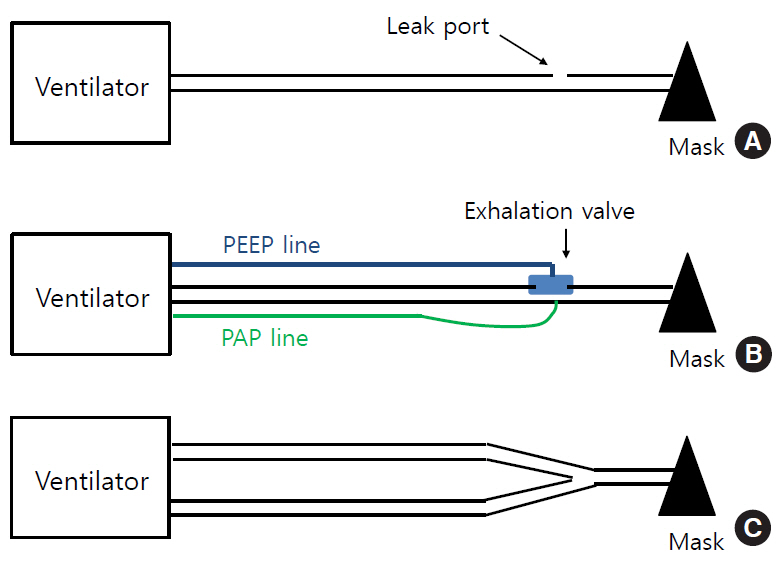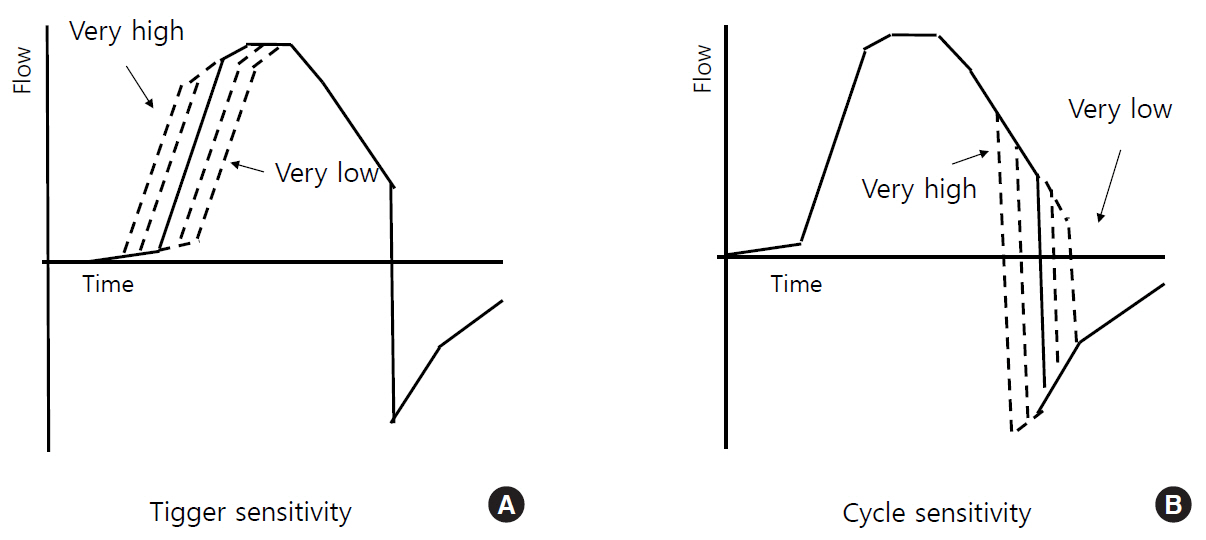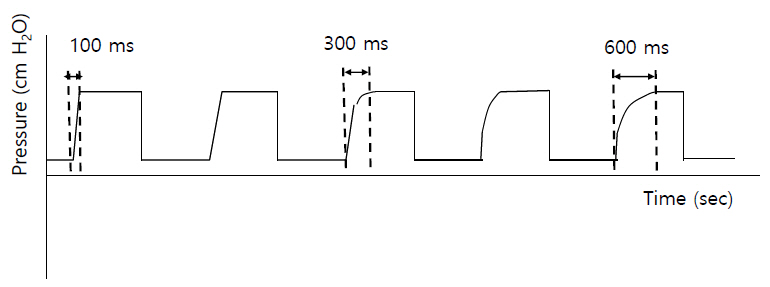Acute Crit Care.
2020 Aug;35(3):131-141. 10.4266/acc.2020.00514.
Home mechanical ventilation: back to basics
- Affiliations
-
- 1epartment of Pulmonary, Allergy and Critical Care Medicine, Hallym University Sacred Heart Hospital, Anyang, Korea
- 2Lane Fox Respiratory Service, Guy’s and St Thomas’ NHS Foundation Trust, St Thomas’ Hospital, London, UK
- KMID: 2506091
- DOI: http://doi.org/10.4266/acc.2020.00514
Abstract
- Over recent decades, the use of home mechanical ventilation (HMV) has steadily increased worldwide, with varying prevalence in different countries. The key indication for HMV is chronic respiratory failure with alveolar hypoventilation (e.g., neuromuscular and chest wall disease, obstructive airway diseases, and obesity-related respiratory failure). Most modern home ventilators are pressure-targeted and have sophisticated modes, alarms, and graphics, thereby facilitating optimization of the ventilator settings. However, different ventilators have different algorithms for tidal volume estimation and leak compensation, and there are also several different circuit configurations. Hence, a basic understanding of the fundamentals of HMV is of paramount importance to healthcare workers taking care of patients with HMV. When choosing a home ventilator, they should take into account many factors, including the current condition and prognosis of the primary disease, the patient’s daily performance status, time (hr/day) needed for ventilator support, family support, and financial costs. In this review, to help readers understand the basic concepts of HMV use, we describe the indications for HMV and the factors that influence successful delivery, including interface, circuits, ventilator accessories, and the ventilator itself.
Keyword
Figure
Reference
-
1. Lloyd-Owen SJ, Donaldson GC, Ambrosino N, Escarabill J, Farre R, Fauroux B, et al. Patterns of home mechanical ventilation use in Europe: results from the Eurovent survey. Eur Respir J. 2005; 25:1025–31.
Article2. MacIntyre EJ, Asadi L, Mckim DA, Bagshaw SM. Clinical outcomes associated with home mechanical ventilation: a systematic review. Can Respir J. 2016; 2016:6547180.
Article3. Garner DJ, Berlowitz DJ, Douglas J, Harkness N, Howard M, McArdle N, et al. Home mechanical ventilation in Australia and New Zealand. Eur Respir J. 2013; 41:39–45.
Article4. Kim HI, Cho JH, Park SY, Lee YS, Chang Y, Choi WI, et al. Home mechanical ventilation use in South Korea based on national health insurance service data. Respir Care. 2019; 64:528–35.
Article5. Hind M, Polkey MI, Simonds AK. AJRCCM: 100-year anniversary. homeward bound: a centenary of home mechanical ventilation. Am J Respir Crit Care Med. 2017; 195:1140–9.6. Simonds AK. Home mechanical ventilation: an overview. Ann Am Thorac Soc. 2016; 13:2035–44.
Article7. Kacmarek RM, Malhotra A. Equipment required for home care ventilation. In : Tobin MJ, editor. Principles and practice of mechanical ventilation. 2nd ed. New York: McGraw Hill;2006. p. 97–127.8. Battisti A, Tassaux D, Janssens JP, Michotte JB, Jaber S, Jolliet P. Performance characteristics of 10 home mechanical ventilators in pressure-support mode: a comparative bench study. Chest. 2005; 127:1784–92.9. Vitacca M, Barbano L, D’Anna S, Porta R, Bianchi L, Ambrosino N. Comparison of five bilevel pressure ventilators in patients with chronic ventilatory failure: a physiologic study. Chest. 2002; 122:2105–14.10. Kieny P, Chollet S, Delalande P, Le Fort M, Magot A, Pereon Y, et al. Evolution of life expectancy of patients with Duchenne muscular dystrophy at AFM Yolaine de Kepper centre between 1981 and 2011. Ann Phys Rehabil Med. 2013; 56:443–54.
Article11. Chatwin M, Tan HL, Bush A, Rosenthal M, Simonds AK. Long term non-invasive ventilation in children: impact on survival and transition to adult care. PLoS One. 2015; 10:e0125839.
Article12. National Institute for Health and Care Excellence. Motor neurone disease: assessment and management. NICE guideline [NG42]. London: National Institute for Health and Care Excellence;[cited 2020 Aug 28]. Available from: https://www.nice.org.uk/guidance/ng42.13. Bourke SC, Tomlinson M, Williams TL, Bullock RE, Shaw PJ, Gibson GJ. Effects of non-invasive ventilation on survival and quality of life in patients with amyotrophic lateral sclerosis: a randomised controlled trial. Lancet Neurol. 2006; 5:140–7.
Article14. Gruis KL, Brown DL, Schoennemann A, Zebarah VA, Feldman EL. Predictors of noninvasive ventilation tolerance in patients with amyotrophic lateral sclerosis. Muscle Nerve. 2005; 32:808–11.
Article15. Farrero E, Prats E, Povedano M, Martinez-Matos JA, Manresa F, Escarrabill J. Survival in amyotrophic lateral sclerosis with home mechanical ventilation: the impact of systematic respiratory assessment and bulbar involvement. Chest. 2005; 127:2132–8.16. Brochard L, Isabey D, Piquet J, Amaro P, Mancebo J, Messadi AA, et al. Reversal of acute exacerbations of chronic obstructive lung disease by inspiratory assistance with a face mask. N Engl J Med. 1990; 323:1523–30.
Article17. Meduri GU, Conoscenti CC, Menashe P, Nair S. Noninvasive face mask ventilation in patients with acute respiratory failure. Chest. 1989; 95:865–70.
Article18. Plant PK, Owen JL, Elliott MW. Early use of non-invasive ventilation for acute exacerbations of chronic obstructive pulmonary disease on general respiratory wards: a multicentre randomised controlled trial. Lancet. 2000; 355:1931–5.
Article19. Strumpf DA, Millman RP, Carlisle CC, Grattan LM, Ryan SM, Erickson AD, et al. Nocturnal positive-pressure ventilation via nasal mask in patients with severe chronic obstructive pulmonary disease. Am Rev Respir Dis. 1991; 144:1234–9.
Article20. Köhnlein T, Windisch W, Köhler D, Drabik A, Geiseler J, Hartl S, et al. Non-invasive positive pressure ventilation for the treatment of severe stable chronic obstructive pulmonary disease: a prospective, multicentre, randomised, controlled clinical trial. Lancet Respir Med. 2014; 2:698–705.
Article21. Murphy PB, Rehal S, Arbane G, Bourke S, Calverley PM, Crook AM, et al. Effect of home noninvasive ventilation with oxygen therapy vs oxygen therapy alone on hospital readmission or death after an acute COPD exacerbation: a randomized clinical trial. JAMA. 2017; 317:2177–86.22. Murphy PB, Suh ES, Hart N. Non-invasive ventilation for obese patients with chronic respiratory failure: are two pressures always better than one? Respirology. 2019; 24:952–61.
Article23. Hess DR. Respiratory care: principles and practice. 2nd ed. Sudbury: Jones & Bartlett Learning;2012.24. Gramlich T. Basic concepts of noninvasive positive pressure ventilation. In : Pilbeam SP, Cairo JM, editors. Mechanical ventilation: physiological and clinical applications. 4th ed. Philadelphia: Mosby Elsevier;2006. p. 417–40.25. Ellis ER, Bye PT, Bruderer JW, Sullivan CE. Treatment of respiratory failure during sleep in patients with neuromuscular disease: positive-pressure ventilation through a nose mask. Am Rev Respir Dis. 1987; 135:148–52.26. Ellis ER, McCauley VB, Mellis C, Sullivan CE. Treatment of alveolar hypoventilation in a six-year-old girl with intermittent positive pressure ventilation through a nose mask. Am Rev Respir Dis. 1987; 136:188–91.
Article27. McEvoy RD, Thornton AT. Treatment of obstructive sleep apnea syndrome with nasal continuous positive airway pressure. Sleep. 1984; 7:313–25.
Article28. Sullivan CE, Berthon-Jones M, Issa FG. Remission of severe obesity-hypoventilation syndrome after short-term treatment during sleep with nasal continuous positive airway pressure. Am Rev Respir Dis. 1983; 128:177–81.29. Sullivan CE, Issa FG, Berthon-Jones M, Eves L. Reversal of obstructive sleep apnoea by continuous positive airway pressure applied through the nares. Lancet. 1981; 1:862–5.
Article30. Sanborn WG. Microprocessor-based mechanical ventilation. Respir Care. 1993; 38:72–109.31. Richard JC, Carlucci A, Breton L, Langlais N, Jaber S, Maggiore S, et al. Bench testing of pressure support ventilation with three different generations of ventilators. Intensive Care Med. 2002; 28:1049–57.
Article32. Criner GJ, Brennan K, Travaline JM, Kreimer D. Efficacy and compliance with noninvasive positive pressure ventilation in patients with chronic respiratory failure. Chest. 1999; 116:667–75.
Article33. Rabec C, Rodenstein D, Leger P, Rouault S, Perrin C, Gonzalez-Bermejo J, et al. Ventilator modes and settings during noninvasive ventilation: effects on respiratory events and implications for their identification. Thorax. 2011; 66:170–8.
Article34. Storre JH, Huttmann SE, Ekkernkamp E, Walterspacher S, Schmoor C, Dreher M, et al. Oxygen supplementation in noninvasive home mechanical ventilation: the crucial roles of CO2 exhalation systems and leakages. Respir Care. 2014; 59:113–20.35. Murate T, Mizoguchi K, Amano H, Shimokata K, Matsuda T. Antipurified-protein-derivative antibody in tuberculous pleural effusions. Chest. 1990; 97:670–3.
Article36. Carlucci A, Schreiber A, Mattei A, Malovini A, Bellinati J, Ceriana P, et al. The configuration of bi-level ventilator circuits may affect compensation for non-intentional leaks during volume-targeted ventilation. Intensive Care Med. 2013; 39:59–65.
Article37. Khirani S, Louis B, Leroux K, Delord V, Fauroux B, Lofaso F. Harms of unintentional leaks during volume targeted pressure support ventilation. Respir Med. 2013; 107:1021–9.
Article38. Borel JC, Sabil A, Janssens JP, Couteau M, Boulon L, Lévy P, et al. Intentional leaks in industrial masks have a significant impact on efficacy of bilevel noninvasive ventilation: a bench test study. Chest. 2009; 135:669–77.39. Fernandez Alvarez R, Rubinos Cuadrado G, Rodriguez Jerez F, Garcia Garcia A, Rodriguez Menendez P, Casan Clara P. Home mechanical ventilation through mask: monitoring leakage and nocturnal oxygenation at home. Respiration. 2013; 85:132–136.
Article40. Miyoshi E, Fujino Y, Uchiyama A, Mashimo T, Nishimura M. Effects of gas leak on triggering function, humidification, and inspiratory oxygen fraction during noninvasive positive airway pressure ventilation. Chest. 2005; 128:3691–8.
Article41. Contal O, Vignaux L, Combescure C, Pepin JL, Jolliet P, Janssens JP. Monitoring of noninvasive ventilation by built-in software of home bilevel ventilators: a bench study. Chest. 2012; 141:469–76.42. Luján M, Lalmolda C, Ergan B. Basic concepts for tidal volume and leakage estimation in non-invasive ventilation. Turk Thorac J. 2019; 20:140–6.
Article43. Luján M, Sogo A, Pomares X, Monsó E, Sales B, Blanch L. Effect of leak and breathing pattern on the accuracy of tidal volume estimation by commercial home ventilators: a bench study. Respir Care. 2013; 58:770–7.44. Chatburn RL. Classification of mechanical ventilators. In : Tobin MJ, editor. Principles and practice of mechanical ventilation. 2nd ed. New York: McGraw Hill;2006. p. 37–52.45. Hess DR. Ventilator waveforms and the physiology of pressure support ventilation. Respir Care. 2005; 50:166–86.46. Calderini E, Confalonieri M, Puccio PG, Francavilla N, Stella L, Gregoretti C. Patient-ventilator asynchrony during noninvasive ventilation: the role of expiratory trigger. Intensive Care Med. 1999; 25:662–7.
Article47. Johnson KG, Johnson DC. Treatment of sleep-disordered breathing with positive airway pressure devices: technology update. Med Devices (Auckl). 2015; 8:425–37.
Article48. Ferguson GT, Gilmartin M. CO2 rebreathing during BiPAP ventilatory assistance. Am J Respir Crit Care Med. 1995; 151:1126–35.49. Lofaso F, Brochard L, Touchard D, Hang T, Harf A, Isabey D. Evaluation of carbon dioxide rebreathing during pressure support ventilation with airway management system (BiPAP) devices. Chest. 1995; 108:772–8.
Article50. Blakeman TC, Branson RD. Evaluation of 4 new generation portable ventilators. Respir Care. 2013; 58:264–72.51. Mandal S, Ramsay M, Suh ES, Harding R, Thompson A, Douiri A, et al. External heated humidification during non-invasive ventilation set up: results from a pilot cross-over clinical trial. Eur Respir J. 2020; 55:1901126.
Article52. Blakeman TC, Rodriquez D Jr, Hanseman D, Branson RD. Bench evaluation of 7 home-care ventilators. Respir Care. 2011; 56:1791–8.
Article53. Make BJ, Hill NS, Goldberg AI, Bach JR, Criner GJ, Dunne PE, et al. Mechanical ventilation beyond the intensive care unit. Report of a consensus conference of the American College of Chest Physicians. Chest. 1998; 113:289S–344S.54. Senent C, Lepaul-Ercole R, Chiner E, Lamouroux C, Similowski T, Gonzalez-Bermejo J. Home mechanical ventilators: the point of view of the patients. J Eval Clin Pract. 2010; 16:832–4.
Article55. Muñoz-Bonet JI, López-Prats JL, Flor-Macián EM, Cantavella T, Bonet L, Domínguez A, et al. Usefulness of telemedicine for home ventilator-dependent children. J Telemed Telecare. 2020; 26:207–15.
Article
- Full Text Links
- Actions
-
Cited
- CITED
-
- Close
- Share
- Similar articles
-
- Home mechanical ventilation in children with chronic respiratory failure: a narrative review
- Home Mechanical Ventilation in South Korea
- The Comparative Study of Central Venous Pressure Measurements during Mechanical Ventilation and after Disconnection of Ventilation
- Home Mechanical Ventilation of Pediatric Patients
- Treatment of acute respiratory failure: invasive mechanical ventilation





